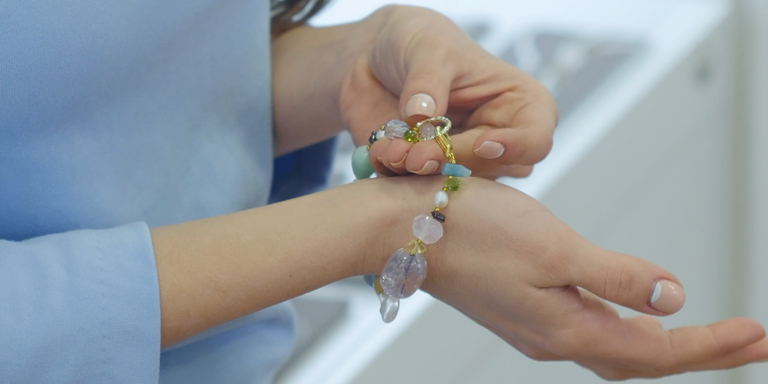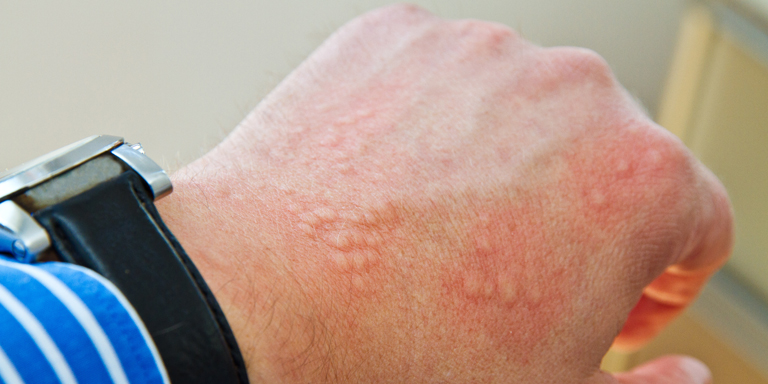Contact dermatitis
Contact dermatitis – also known as contact eczema – is an inflammatory non-infectious reaction of the skin to external substances and influences.

Table of contents:
Contact dermatitis is one of the most common forms of skin disease. Around 15 percent of the European population report experiencing contact dermatitis at some point in their lives.
Causes and forms
In contact dermatitis (also known as contact eczema), the skin becomes inflamed on contact with substances it does not tolerate.
Numerous triggers are known. These are found, for instance, in jewellery, cosmetics, shampoos, hair dyes, disinfectants, cleaning products and various construction materials.
There are two different mechanisms that may result in contact dermatitis.
Allergic contact dermatitis
Allergic eczema occurs when the skin comes into contact with a trigger allergen. Eczema may present within a few days of initial contact with the allergen. However, skin changes may also first occur weeks or even months after constant or repeated contact.
In most cases, the allergen is a chemical, such as:
- preservatives such as formaldehyde or isothiazolinone / methylisothiazolinone in cosmetics and hair shampoos
- fragrances such as citronellol in personal care products and cleaning agents
- colourants such as p-phenylendiamine in dark hair dyes
- metals such as nickel in costume jewellery.
Allergic contact dermatitis usually heals completely when all contact with the allergen is avoided.
Irritative contact dermatitis
Irritative eczema, on the other hand, is not an allergic reaction but results from exposure to a skin irritant. Irritative contact dermatitis is more common than allergic eczema. Approximately 80 percent of known cases are classified as irritant contact dermatitis, which typically develops over an extended period.
The hands are most commonly affected, following exposure to physical and chemical irritants:
- water, e.g. with repeated washing of the hands
- UV-radiation from the sun
- moisture, e.g. saliva around the mouth
- cleaning agents (both domestic and industrial)
- solvents
- cement.
Symptoms
A distinction is made between acute and chronic eczema in both the allergic and irritative forms, based on the symptoms.
Acute contact dermatitis
- redness in the area of skin in contact with the allergen
- itching (more likely allergic) or burning (more likely irritative)
- pustules or blisters
- weeping when pustules spontaneously burst, eventually resulting in crusts and scaling
Chronic contact dermatitis
Eczema becomes chronic if the allergen cannot be avoided or the eczema fails to heal even though it is avoided.
Typical signs are:
- itching
- redness
- dry and / or scaling skin
- coarsening or thickening of the skin
- painful cracks in the skin.
Diagnosis
Allergic contact dermatitis
The doctor or specialist first seeks to identify the cause of the eczema by asking detailed questions and conducting a thorough examination. A skin test (epicutaneous or patch test) is then performed.
Irritative contact dermatitis
There is no diagnostic test for irritative eczema, which makes it hard to identify the precise cause. The doctor therefore also seeks to identify the cause by asking detailed questions about the sufferer’s daily routine, work and hobbies.
Treatment
It is very important to avoid the causative irritant in both allergic and irritative contact dermatitis. This allows the eczema to heal and prevents a prolonged course. Once the cause has been identified, it is important to find alternatives or take appropriate preventive measures.
Good skin care can help restore the skin’s protective barrier.
Severe eczema should be treated with topical cortisone or immunomodulators on consultation with a doctor.
Tips and tricks
- The best way to reduce the risk of occupational contact dermatitis of the hands is to wear appropriate gloves and practise good skin care.
- When buying cosmetics, take care to choose products that are well tolerated and do not contain potential allergens or irritants.
- The International Nomenclature for Cosmetic Ingredients (INCI) stipulates what information must be given about these substances. For the database, go to www.haut.de.
- When buying costume jewellery, ensure that it does not contain any nickel alloys. If in doubt, objects can be tested for nickel in pharmacies.
- When shopping, look out for products with the Allergy Seal of Quality, these are particularly suitable for people with allergies and intolerances and are recommended by aha! Swiss Allergy Centre.
Facts and figures
Contact dermatitis is one of the most common forms of skin disease. Around 15 percent of the European population report experiencing contact dermatitis at some point in their lives.
Editors: aha! Swiss Allergy Centre in co-operation with the Scientific Advisory Board.




